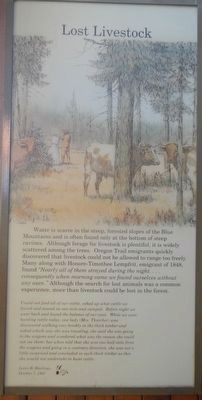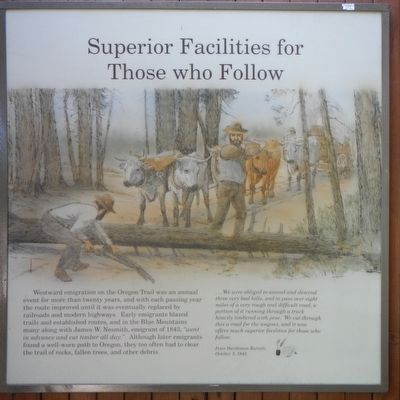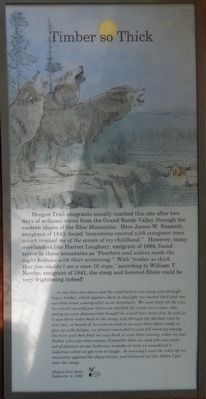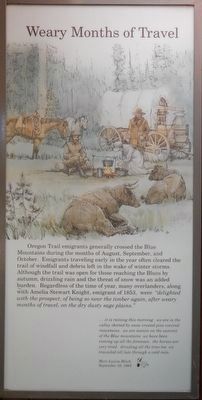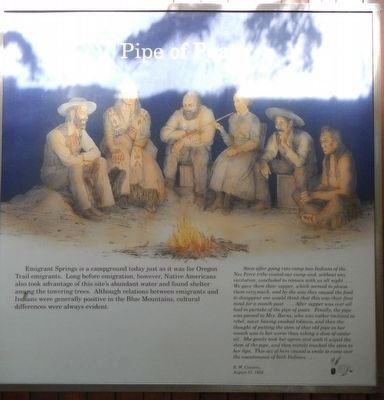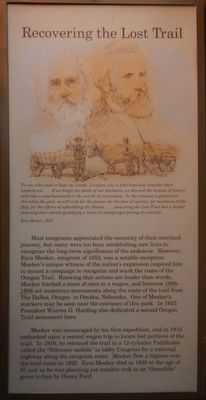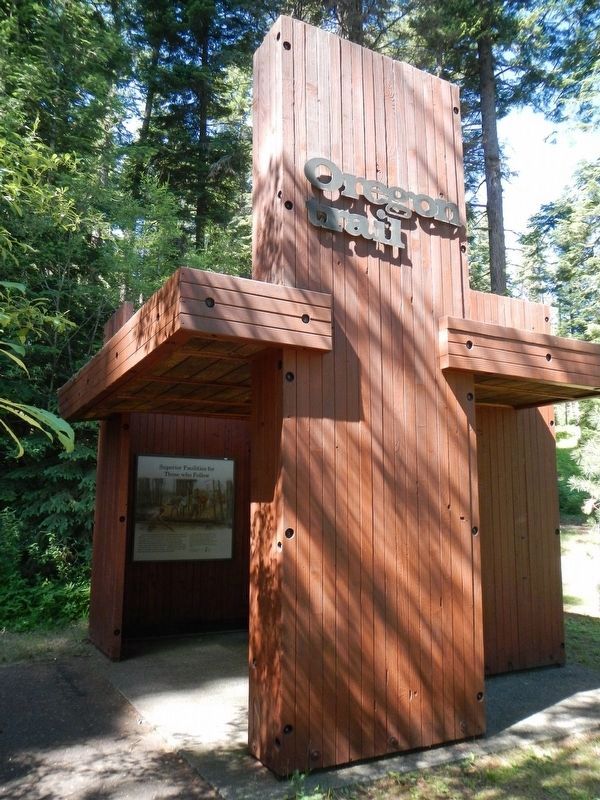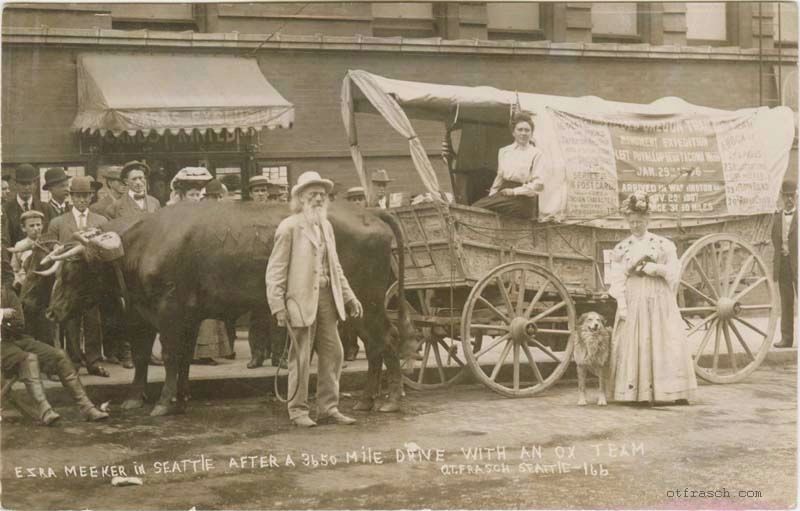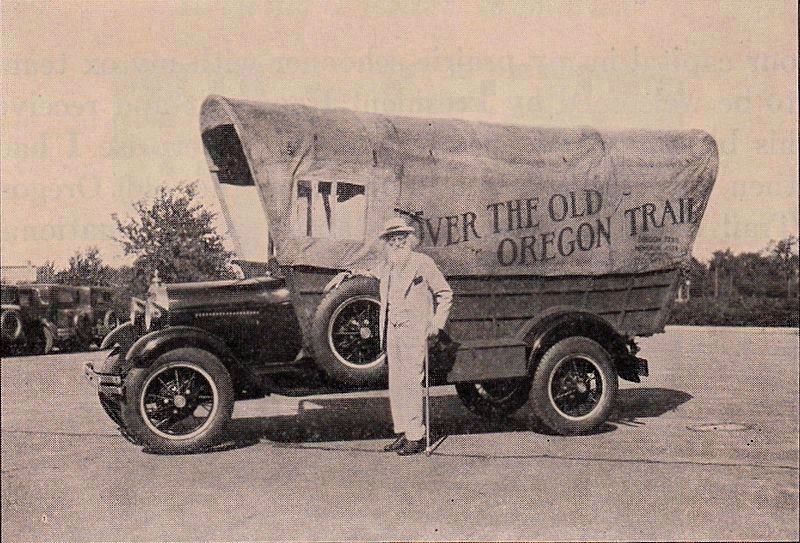Near Meacham in Umatilla County, Oregon — The American West (Northwest)
Emigrant Springs Oregon Trail Kiosk
Water is scarce in the steep, forested slopes of the Blue Mountains and is often found only at the bottom of steep ravines. Although forage for livestock is plentiful, it is widely scattered among the trees. Oregon Trail emigrants quickly discovered that livestock could not be allowed to range to free. Many along with Honore-Timothee Lempfrit, emigrant of 1848, found "Nearly all of them strayed during the night.... consequently when morning came we found ourselves without any oxen." Although the search for lost animals was a common experience, more than livestock could be lost in the forest.
Could not find all of our cattle, yoked up what cattle we found and moved on one mile and camped. Before night we went back and found the balance of our oxen. While we were hunting cattle today, one lady (Mrs Thatcher) was discovered walking very briskly in the thick timber and asked which way she was traveling, she said she was going the wagons and wondered what was the reason she could not see them; but when told that she was one-half mile from the wagons and going in a contrary direction, she was not a little surprised and concluded in such thick timber as this she would not undertake to hunt cattle. -- Loren B. Hastings, October 7, 1847
Westward emigration on the Oregon Trail was an annual event for more than twenty years, and with each passing year the route improved until it was eventually replaced by railroads and modern highways. Early emigrants blazed trails and established routes, and in the Blue Mountains many along with James W. Nesmith, emigrant of 1843, "went in advance and cut timber all day." Although later emigrants found a well-worn path to Oregon, they too often had to clear the trail of rocks, fallen trees and other debris.
... We were obliged to ascend and descend three very bad hills, and to pass over eight miles of a very rough and difficult road, a portion of it running through a track heavily timbered with pine. We cut through this a road for the wagons, and it now offers much superior facilities for those who follow. -- Peter Hardeman Burnett, October 3, 1843
Oregon Trail emigrants usually reached this site after two days of arduous travel from the Grande Ronde Valley through the eastern slopes of Blue Mountains. Here James W. Nesmith, emigrant of 1843, found "mountains covered with evergreen trees which remind me of the scenes of my childhood." However, many overlanders like Harriet Loughary, emigrant of 1864, found terror in these mountains as "Panthers, and wolves made the night hideous with their screaming." With "timber so thick that you couldn't see a man 10 steps." according to William T. Newby, emigrant of 1841, the steep and forested Blues could be very frightening indeed!.
... it was then sun-down and the road back to our camp was through heavy timber, which appeared dark in daylight; we started back and met our little sister coming after us on horseback; We went back all the way in a hard run and just before we reached the camp met a man, who seeing we were disconcerted thought he would have some fun; he told us it was three miles back to camp, and through the darkest road he ever saw, or heard of; he went on and as we were then about ready to give up with fatigue, we almost concluded to wait till morning among the trees and then find our way back or wait their coming, when we met Father who was more uneasy if possible than we, and who was quite out of patience at our ludicrous mistake at least we considered it ludicrous when we got time to laugh: In running I wore the soles off my moccasins against the sharp stones, and blistered my feet before I got near the camp. -- Abigail Jane Scott, September 4, 1852
Oregon Trail emigrants generally crossed the Blue Mountains during the months of August, September, and October. Emigrants traveled early in the year often clearing the trail of windfall and debris left in the wake of winter storms. Although the trail was open for those reaching the Blues by autumn, drizzling rain and the threat of snow was an added burden. Regardless of the time of year, many overlanders, along with Amelia Stewart Knight emigrant of 1853, were "delighted with the prospect, of being so near the timber again, after weary months of travel, on the dry dusty sage plains."
... it is raining this morning. we are in the valley skirted by snow crested pine covered mountains. we are noonin on the summit of the Blue mountains we have been coming up all the forenoon. the horses are very tired. drizzling all the time too we travailed till late through a cold rain. -- Mary Louisa Black, September 10, 1864
Emigrant Springs is a campground today just as it was for Oregon Trail emigrants. Long before emigration, however, Native Americans also took advantage of this site's abundant water and found shelter among the towering trees. Although relations between emigrants and Indians were general positive in the Blue Mountains, cultural differences were always evident.
Soon after going into camp two Indians of the Nez Perce tribe visited our camp and, without any invitation, concluded to remain with us all night... We gave them supper, which seem to please them very much, and by the way they caused the food to disappear one would think that this was their first meal for a month past. ... After supper was over all had to partake of the pipe of peace. Finally, the pipe was passed to Mrs. Burns, who was rather inclined to rebel, never having smoked tobacco, and then the thought of putting the stem of that old pipe in her mouth was to her worse than taking a dose of castor oil. She gently took her apron and with it wiped the stem of the pipe, and then merely touched the stem to her lips. This act of hers caused a smile to come over the countenance of both Indians. ... -- E.W. Conyers, August 31, 1852
To you who read or hear my words, I conjure you to take heed and consider their importance. ... If we forget the deeds of our forebears, we discard the lessons of history and take a step backwards in the march of civilization. In the measure a generation cherishes the past, so will it be for the future; for the love of country; for reverence of the flag; for the efforts of upbuilding the Nation. ... recovering the Lost Trail has a deeper meaning than merely gratifying a whim or satisfying a feeling of curiosity. -- Ezra Meeker, 1915
Most emigrants appreciated the enormity of their overland journey, but many were too busy establishing new lives to recognize the long-term significance of the endeavor. However, Ezra Meeker, emigrant of 1852, was a notable exception. Meeker's unique witness of the nation's expansion inspired him to mount a campaign to recognize and mark the route of the Oregon Trail. Knowing that actions are louder than words, Meeker hitched a team of oxen to a wagon, and between 1906-1908 set numerous monuments along the route of the trail from The Dalles, Oregon to Omaha, Nebraska. One of Meeker's markers may be seen near the entrance to this park. In 1923 President Warren G. Harding also dedicated a second Oregon Trail monument here.
Meeker was encouraged by his first expedition, and in 1910 embarked upon a second wagon trip to locate lost portions of the trail. In 1916, he retraced the trail in a 12-cylinder Pathfinder called the "Schooner-mobile" to lobby Congress for a national highway along the emigrant route. Meeker flew a biplane over the trail route in 1925. Ezra Meeker died in 1928 at the age of 97 just as he was planning yet another trek in an "Oxmobile" given to him by Henry Ford.
Erected by Oregon Trail Coordinating Council (OTCC).
Topics and series. This historical marker is listed in these topic lists: Railroads & Streetcars • Settlements & Settlers. In addition, it is included in the Former U.S. Presidents: #29 Warren G. Harding, and the Oregon Trail series lists. A significant historical date for this entry is September 4, 1852.
Location. 45° 32.544′ N, 118° 27.78′ W. Marker is near Meacham, Oregon, in Umatilla County. Marker can be reached from Old Oregon Trail near Interstate 84, on the left when traveling north. Touch for map. Marker is at or near this postal address: 65068 Old Oregon Trail, Meacham OR 97859, United States of America. Touch for directions.
Other nearby markers. At least 8 other markers are within 13 miles of this marker, measured as the crow flies. The Intrepid Pioneers (here, next to this marker); Emigrant Springs State Park (about 700 feet away, measured in a direct line); Meacham (approx. 3.1 miles away); Oregon Trail Memorial (approx. 3.2 miles away); Deadman Pass Oregon Trail Kiosk (approx. 4.6 miles away); Oregon Scenic Highways (approx. 8.2 miles away); Parade of Survivors (approx. 12.2 miles away); On This Ridge... (approx. 12.2 miles away). Touch for a list and map of all markers in Meacham.
More about this marker. This kiosk is located in Emigrant Springs State Park.
Credits. This page was last revised on August 1, 2020. It was originally submitted on December 15, 2017, by Barry Swackhamer of Brentwood, California. This page has been viewed 398 times since then and 32 times this year. Photos: 1, 2, 3, 4, 5, 6, 7, 8, 9. submitted on December 15, 2017, by Barry Swackhamer of Brentwood, California.
